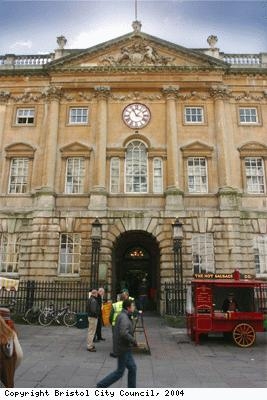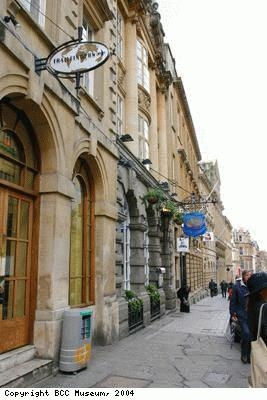Page 265 of 352 pages « First < 263 264 265 266 267 > Last »
Historic site, Colston Hall

Description:
Photograph of Historic site, Colston Hall, Colston Street.Colston was a prominent sugar merchant, charitable donator, and an official on the board of London-based trading company, the Royal African Company. Built in 1867 on the site of the Great House owned by Sir John Young, a leading merchant. In 1653 the house was converted by John Knight (junior) into Bristol’s first sugar house refining sugar from the Caribbean. The refinery was supplied sugar by slave plantations on the Caribbean islands of Nevis, Montserrat and Barbados, some of which were owned by Bristol merchants. In 1708 the sugar warehouses were converted into Colston’s Hospital (which later became Colston’s Boys School).
With thanks to the authors of the Slave Trade Trail around Central Bristol, Madge Dresser, Caletta Jordan, Doreen Taylor.
Creator: David Emeney
Date: 2003
Copyright: Copyright BCC Museum
Historic site, Three Sugar Loaves Pub

Description:
Photograph of Historic site, The Three Sugar Loaves public house.This pub got its name from the site of a nearby sugar processing house, destroyed by fire in 1859. Fire was a hazard in the sugar refining industry, between 1670 and 1859, no fewer than 11 sugar houses were destroyed by fire.Owing to the high insurance costs sugar merchants started their own insurance firms, the first being the Bristol Fire Office, founded in 1718. By 1837 this was absorbed into the Sun Fire Office.This was the city’s only fire service until the Police Fire Brigade Service was formed in 1877.
With thanks to the authors of the Slave Trade Trail around Central Bristol, Madge Dresser, Caletta Jordan, Doreen Taylor.
Creator: David Emeney
Date: 2003
Copyright: Copyright BCC Museum
Object ID:DME0008
Historic site, Broad Street

Description:
Photograph of Historic site, Broad Street. The first open meeting in Bristol on the abolition of the slave trade occurred in 1788, in the medieval Guild Hall (now demolished) in Broad Street. A petition was drawn up there and signed by, among others, Alderman John Harris, George Daubeny (Merchant Venturer and one time mayor), Josiah Tucker (by then the Dean of Gloucester), the Dean of Bristol, the Baptist minister Caleb Evans and the radical minister of Lewin’s Mead congregation, John Prior Estlin.
With thanks to the authors of the Slave Trade Trail around Central Bristol, Madge Dresser, Caletta Jordan, Doreen Taylor.
Creator: David Emeney
Date: 2003
Copyright: Copyright BCC Museum
Historic site, Tailors Court

Description:
Photograph of Historic site, Tailors Court, off Broad Street, Bristol. At the end of the court on the right-hand side is Court House . This was where William Miller lived, a grocer, banker and founder member of the Company of Merchants Trading to Africa. He died in 1781 a very wealthy man, leaving 190,000 pounds.
With thanks to the authors of the Slave Trade Trail around Central Bristol, Madge Dresser, Caletta Jordan, Doreen Taylor.
Creator: David Emeney
Date: 2003
Copyright: Copyright BCC Museum
Historic site, The Commercial Rooms

Description:
Photograph of Historic site, The Commercial Rooms, Corn Street. Now a pub, the Commercial Rooms were built in 1810 (three years after the end of the slave trade) as a new centre fro Bristol’s businessmen.The site was formerly occupied by another of Bristol’s famous coffee houses, Foster’s Coffee House.The exterior of the building has statues representing Bristol, Commerce and Navigation, which are sometimes referred to as the three commercial graces.One carving shows Britannia checking the monies due to her from the rest of the world.
With thanks to the authors of the Slave Trade Trail around Central Bristol, Madge Dresser, Caletta Jordan, Doreen Taylor.
Creator: David Emeney
Date: 2003
Copyright: Copyright BCC Museum
Historic site, The Nat West Bank

Description:
Photograph of Historic site, The National Westminster Bank, Corn Street.A plaque on the wall commemorates The Old Bank, originally set up in nearby Broad Street in 1750.This was one of the banks that eventually merged into the National Westminster Bank. In the late 18th century The Old Bank moved to what is now the Wig and Pen pub. All but one of the bank’s founders were traders to Africa, including Merchant Venturer Isaac Elton.This demonstrates the connection between Bristol’s slave trade and the development of the banking system.
With thanks to the authors of the Slave Trade Trail around Central Bristol, Madge Dresser, Caletta Jordan, Doreen Taylor.
Creator: David Emeney
Date: 2003
Copyright: Copyright BCC Museum
Historic site, Corn Exchange

Description:
Historic site, Corn Exchange, Corn Street. This was built in 1753, replacing less grand facilities on the site for Bristol’s merchants. Despite its name, it was intended for merchants of all types, and a number directly involved in the West African and Caribbean trade used it for business transactions. However, it seems that most African and American merchants preferred the more informal atmosphere of the nearby coffee houses to do business.
Inside the Corn Exchange in the main chamber are emblems representing Asia, Africa, and America.(The female figure of America wears a head-dress of tobacco leaves).On the outside of the building are carvings of African, American, Asia and European figures and animals, again symbols of Bristol’s foreign trade.
With thanks to the authors of the Slave Trade Trail around Central Bristol, Madge Dresser, Caletta Jordan, Doreen Taylor.
Creator: David Emeney
Date: 2003
Copyright: Copyright Bristol City Council
Historic site, 56 Corn Street

Description:
Photograph of Historic site, 56 Corn Street. Many goods were sold informally at coffee houses.In April 1758, a local newspaper called Felix Farley’s Bristol Journal announced an auction to be held here. It was for the sale of 100 hogsheads (or barrels containing 272 kilos) of white sugar and the 70 casks of coffee, captured from a French ship in the Caribbean. From the mid-18th century, rewards for runaway slaves and the sale of slaves from the plantations were advertised in Bristol�s newspapers, which were widely read in the city�s coffee houses.On 12th January 1754 an advertisement in the Bristol Intelligencer announced: For sale [to] any gentleman or lady who wants a Negro Boy, a lad of 14 years recently landed [from the Caribbean].
With thanks to the authors of the Slave Trade Trail around Central Bristol, Madge Dresser, Caletta Jordan, Doreen Taylor.
The language used to describe people of African descent in the 18th, 19th and 20th centuries is unacceptable in today’s terms. We cannot avoid using this language in its original context. To change the words would impose 20th century attitudes on history.Creator: David Emeney
Date: 2003
Copyright: Copyright BCC Museum
Historic site, Corn Street.

Description:
Historic site, Corn Street, Bristol. The trade in Africans and in the slave-produced commodities from America and the Caribbean (such as sugar, chocolate, coffee and cotton) meant more money came to Bristol.This money had to be administered. Loans were needed, slaving and cargo ships had to be insured, as did the sugar refineries and warehouses where fire was a constant threat. Goods had to be sold off and commission needed to be paid. In this way, financial services could be said to have been stimulated by the success of this trade. By the mid-18th century, Corn Street became a focus for the city�s banks, insurance offices and coffee houses.
With thanks to the authors of the Slave Trade Trail around Central Bristol, Madge Dresser, Caletta Jordan, Doreen Taylor.
Chocolate was first used as a drink, sweetened with sugar to mask the bitter flavour of the chocolate. Later it was used for making eating chocolate. At this period, most people drank beer, wine or spirits. Water was not safe to drink, tea coffee and chocolate were expensive. Quakers promoted drinking chocolate as an alternative to alcohol.
Creator: David Emeney
Date: 2003
Copyright: Copyright BCC Museum
Corner of Great George Street, Bristol

Description:
Photograph of the corner of Great George Street, Bristol. Part of the Slave Trail.
Creator: David Emeney
Date: unknown
Copyright: Copyright BCC Museum
Page 265 of 352 pages « First < 263 264 265 266 267 > Last »

